Piazza del Duomo - Table of Contents
![]()
Piazza
del Duomo - Table of Contents
Florence
Campanile
/Bell Tower
Florence, Italy
|
Erected: |
Begun in the 11th century and finished, in the decorative parts, two centuries later. |
| The
Campanile, or Bell Tower is part of the Duomo complex, which includes
the Cathedral of Santa Maria del Fiore (Duomo) and the Baptistery. |
|
|
Architect: |
|
|
Style: |
Tuscan Gothic |
| The Campanile
is a splendid
example of Florentine Gothic
architecture from the 1300’s. It was started in 1334 when Giotto, one of the principle artists and architects of the time, began to build the bell tower for the church, placing it next to the church. Even though the bell tower is named after Giotto, he actually only worked on it for three years before his death. After the death of Giotto, the next person to work on the tower was Andrea Pisano, who following the original design, finished the first two floors and then it was completed in 1359 by Francesco Talenti, after the Black Plague interrupted the work done by Andrea. The rooftop terrace and the highest point where one can reach was actually an idea of Talenti. The square base is approximately 15 meters. The tower reaches 84,70 meters in height and stands next to the Duomo, with which it shares a similar facade made of red, white and green marble inlay. The sculpted decorations on the outside of the tower are extremely rich in detail, in the form of a hexagon or a rhombus or diamond shape with bas relief carvings and life size statues. The lozenges shaped carvings represent the concept of Universal order and the story of Redemption, while the relief carvings narrate the “Creation of Man” and the influence of the Planets upon Man's life, Man’s virtues and the they reflect the Liberal Arts and the Sacraments. There are also 16 life size statutes placed in various niches which are the composite work of several artists from the 1300 and 1400’s, including Andrea Pisano and Donatello. Over time, these masterpieces have been substituted by copies, but the originals are on view at the Museo dell’Opera del Duomo - Visit Florence (online April 2020) |
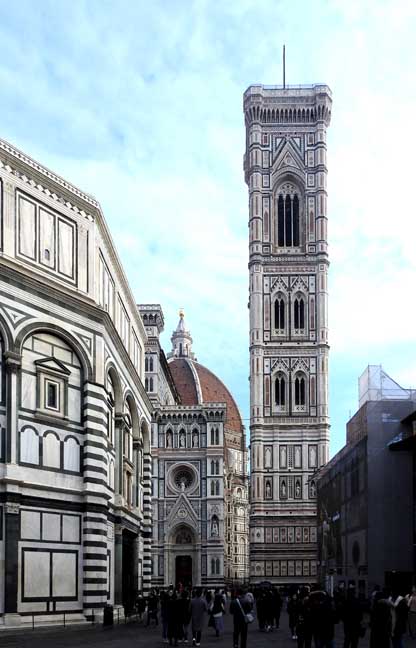 From the left: Baptistery ... Cathedral ... Back of Campanile/Bell tower (entrance is on the other side) 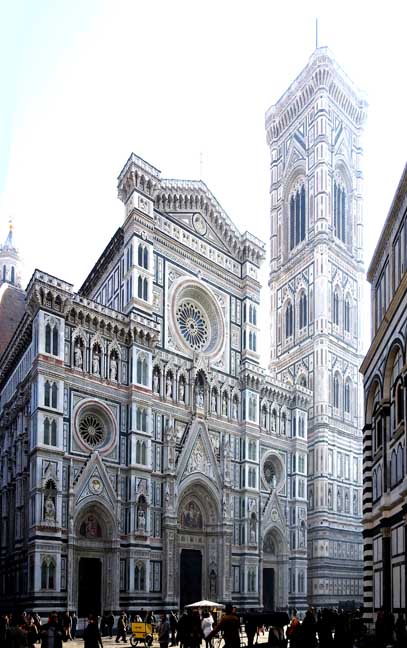 Cathedral ... Campanile/Bell tower 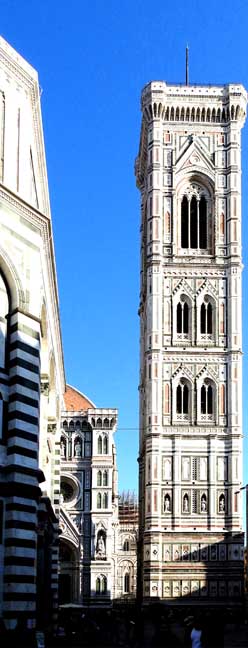 From the left: Baptistery ... Cathedral ... Campanile/Bell tower 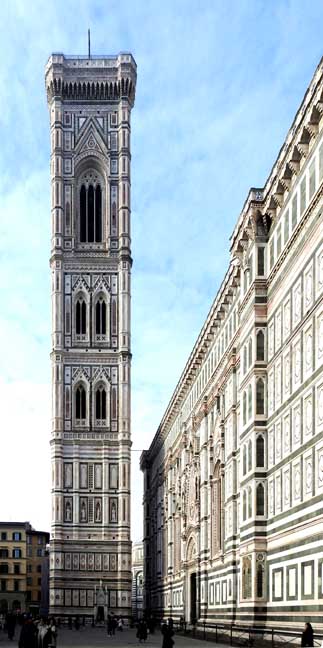 Front/east elevation of Campanile ... Five stories ... South elevation of the Cathedral ... Instead of a filigree skeleton of a Gothic building, Giotto applied a surface of colored marble in geometric patterns. |
|
First Story
The originals of all these sculptures are now kept in the Museo dell'Opera del Duomo for conservation purposes. 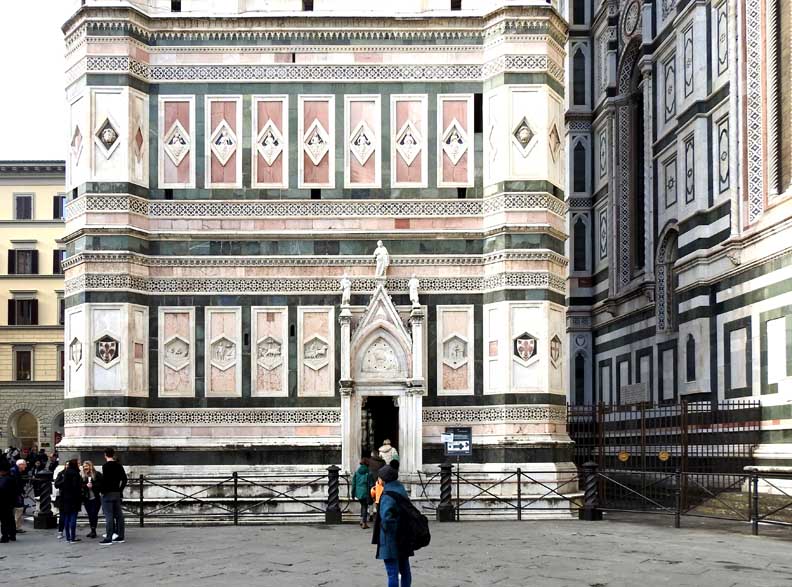 First story Note corner buttresses ... Like the Cathedral, the bell tower is elaborately decorated in white, green, and pink marble. But where the Duomo is expansive, the Campanile is slender and symmetrical. The Campanile was built on a square plan and has five different levels. The first story features hexagonal panels and bas reliefs set in diamond-shaped "lozenges" which depict the Creation of man, Planets, Virtues, Liberal Arts, and Sacraments. ... The originals of all these sculptures are now kept in the Museo dell'Opera del Duomo  First Story Three of the 7 Liberal Arts: Astronomy, Music, Geometry(?) among the 24 lozenges ... Bas-relief 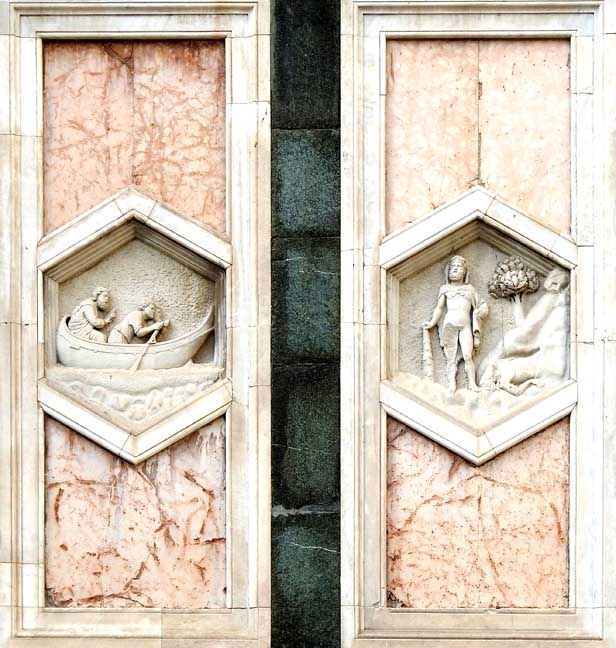 First Story Two of the 26 hexagonal panels: "Navigation" and Social Justice: Hercules and Cacus 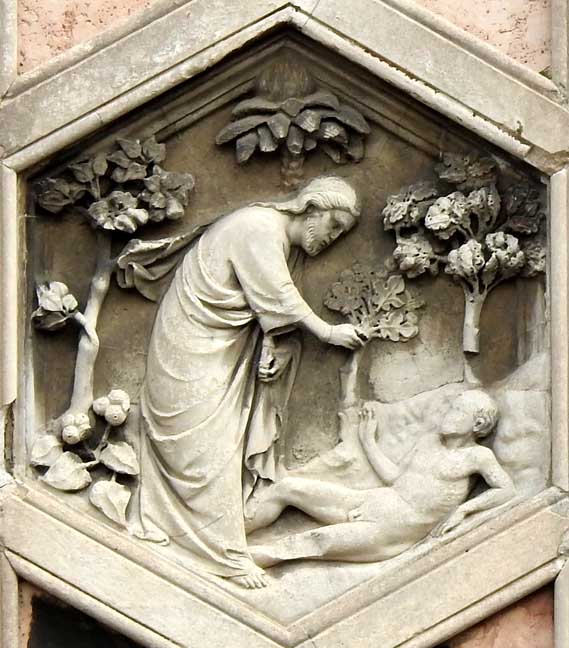 First Story Hexagonal panel: God creates Adam ... Bas-relief ... The originals of all these sculptures are now kept in the Museo dell'Opera del Duomo 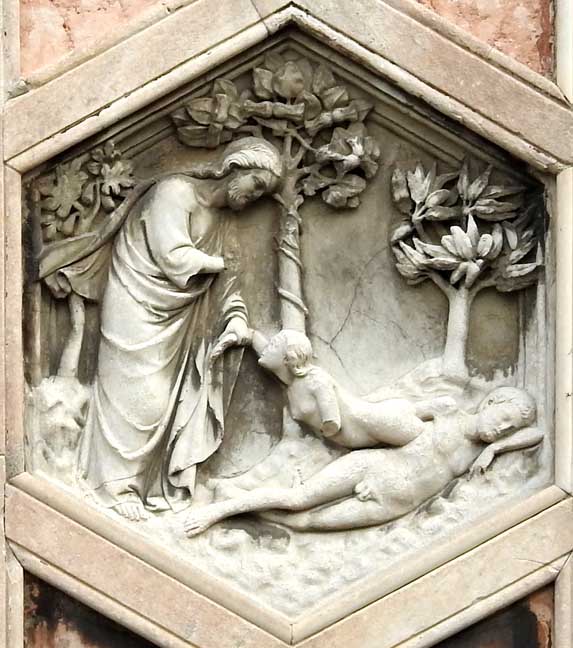 First Story Hexagonal panel: God creates Eve out of the rib of Adam 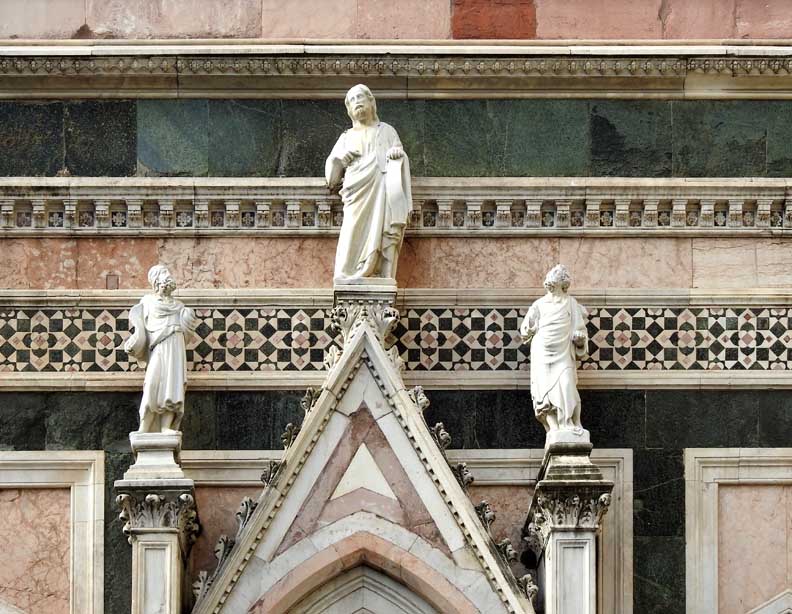 First Story Campanile door surround: Redeemer and two prophets, attributed to Andrea Pisano ... The originals of all these sculptures are now kept in the Museo dell'Opera del Duomo 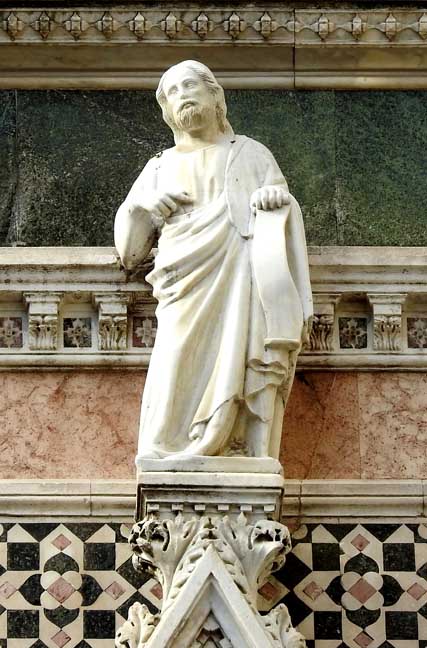 First Story Campanile door surround: Redeemer  First Story Campanile door surround ... Flanking paneled columns with acanthus leaf capitals ... Bas-relief "Lamb of God" in tympanum 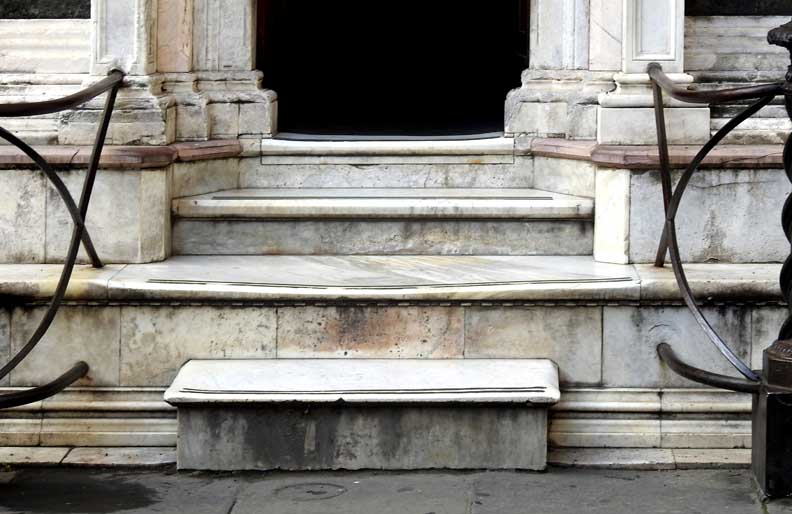 First Story Entrance marble steps |
| Second
Story The originals of all these sculptures are now kept in the Museo dell'Opera del Duomo for conservation purposes. 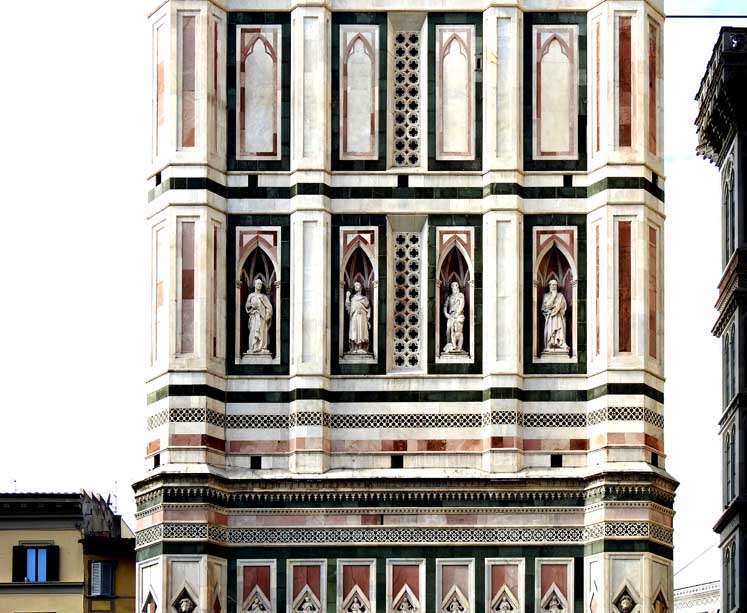 Second
story:
decorated with niches in which there are statues of prophets from
the
Bible. Several of these statues were designed by Donatello, while
others are attributed to Andrea Pisano and Nanni di Bartolo.
First story: features hexagonal panels and reliefs set in diamond-shaped lozenges which depict the Creation of man, Planets, Virtues, Liberal Arts, and Sacraments. The
four sculptures on the East side of the Campanile (over the
door): The Beardless Prophet (Donatello); The Bearded
Prophet (Nanni di Bartolo);
Abraham Sacrificing Isaac (Donatello and Nanni di Bartolo); Il Pensatore (The Thinker, Donatello) ... All sculptures created 1408 to 1421. Note third and fourth sculptures which are illustrated below:  Second story - Prophets from the Bible Donatello's "Abraham & Isaac" ... The original of all this sculpture is now kept in the Museo dell'Opera del Duomo  Second Story - Prophets from the Bible Donatello's "The Thinker" 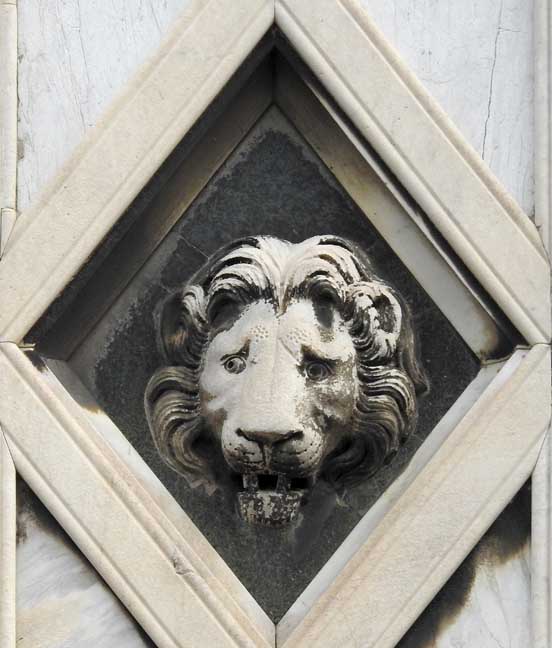 Second Story Buttress lion decoration |
| Third
and fourth stories - Windows and columns The
three top levels were built by Francesco Talenti, Master of the
Works from 1348 to 1359. Each level is larger than the lower one and
extends beyond it in every dimension such that their difference in size
exactly counters the effect of perspective. As a result, the top three
levels of the tower, when seen from below, look exactly equal in size.
Instead of a spire, Talenti built a large projecting terrace.
 Third and fourth stories The third and fourth stories of the bell tower are set with eight windows (two on each side) and each of these is split with twisted Gothic columns. ... Inside the open windows on the three stories are seven bells, cast between 1705-1956 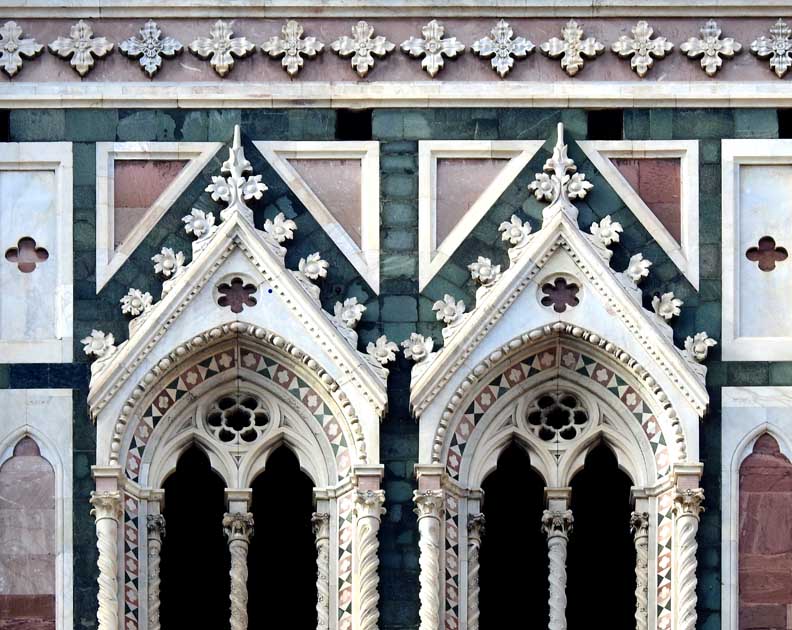 Third and fourth stories Trefoils ... Quatrefoils ... Multifoils ... Bead-and-reel molding ... Twisted Gothic columns |
Fifth
story Fifth story Instead of a spire, architect Francesco Talenti, Master of the Works from 1348 to 1359. built a large projecting terrace. ... Visitors can climb to the top of the Bell tower to the projecting terrace (414 steps) for a view of Florence ... White marble from Carrara, green marble from Prato and red marble from Siena. 2002 photo 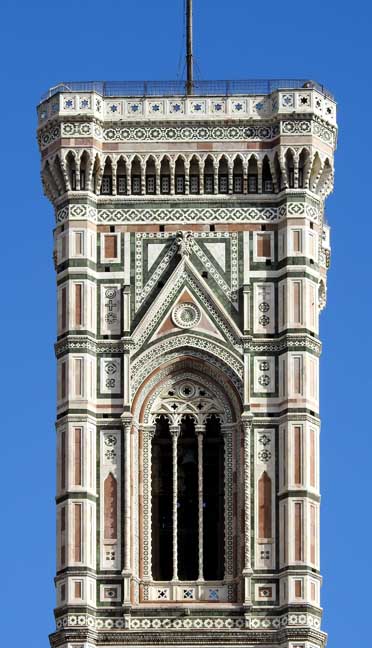 Fifth story This fifth story is the tallest and is set with four tall windows, each split by two columns. The story also features the viewing platform with sweeping views of the rooftops of Florence and the neighboring Duomo. 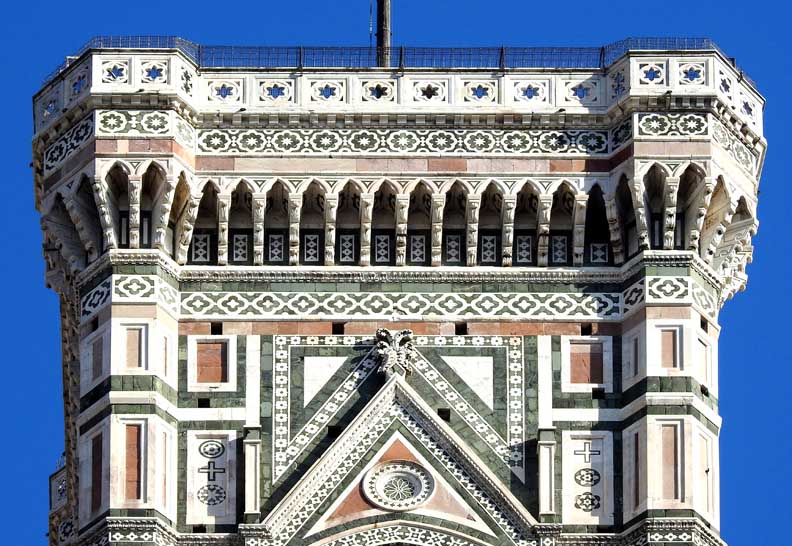 Fifth story Parapeted terrace ... Corbel table ... Encrustation  Fifth story Corbel table 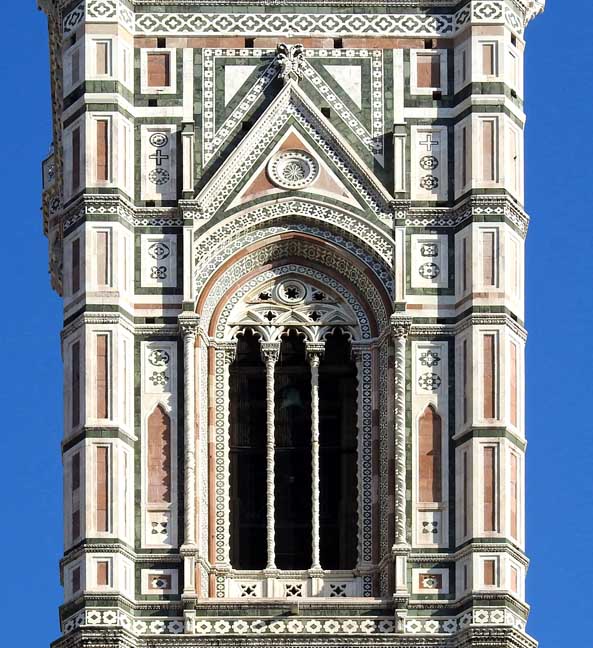 Fifth story |
